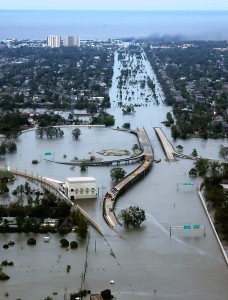
Flooding in New Orleans from Hurricane Katrina. image: Wikipedia
When Hurricane Katrina hit the Gulf Coast 10 years ago, it would become the costliest natural disaster in U.S. history, causing an estimated $108 billion in damages.
It would also be one of the deadliest. The storm caused approximately 1,833 deaths across five states, with the most casualties in Louisiana: 1,577.
Katrina was a Category 3 hurricane when it slammed into Louisiana Aug. 29, 2005, but the damage and devastation would be compounded by a series of human failures: an inadequate levee system that collapsed under a surging storm, leaving 80 percent of New Orleans underwater; a poorly organized evacuation plan that left many residents—mostly black and mostly poor—stranded; and a slow relief response by local and federal governments that made hurricane survivors feel as though they had been abandoned.
A look back at nine key figures who responded to the disaster in Louisiana 10 years ago, what they did during Katrina and what they have been doing since then.
1. President George W. Bush
During Katrina: As Katrina headed toward the Gulf Coast,President Bush was vacationing at his ranch in Texas. On Aug. 27, 2005, he declared a federal state of emergency, giving the Department of Homeland Security and Federal Emergency Management Agency authority to respond. Bush, along with FEMA Director Michael Brown and Secretary of Homeland Security Michael Chertoff, had been warned that the levees might be breached.
Post-Katrina: The Bush administration’s botched response to Katrina remains one of the biggest stains on the president’s legacy.A congressional report on the response to Hurricane Katrina, “A Failure of Initiative” (pdf), noted that “critical elements of the national response plan were executed late, ineffectually or not at all.”
When Bush left office in 2009, he and his family returned to Texas. He is currently a public speaker and released his memoir, Decision Points, in 2010.
2. Louisiana Gov. Kathleen Blanco
During Katrina: On Aug. 26 Blanco declared a state of emergency. On Aug. 27 Blanco, along with other officials from the southeastern-Louisiana parishes, held a press conference to encourage residents to evacuate.
After Katrina made landfall and the levees broke in New Orleans, throwing the city into complete chaos, many pointed at Blanco and her poor communication with Mayor Nagin and the federal government as the main reason help to the city was slow to come.
3. New Orleans Mayor Ray Nagin
During Katrina: On Aug. 27 Nagin addressed the city of New Orleans in a special press conference with Gov. Blanco and other officials to urge residents to evacuate. During the conference, he acknowledged that many residents lacked transportation to flee, and informed residents that the Superdome would be opened as a shelter of last resort for those with special needs. He encouraged evacuees who planned to stay there to bring their own food, drinks and other necessities.
On Aug. 28 he issued the first-ever mandatory evacuation of New Orleans.
With tens of thousands of people gathering at the Superdome, Nagin pleaded with the federal government on CNN for assistance, saying, “This is a desperate SOS.” On Sept. 1 he lashed out at the federal government during an interview with New Orleans radio station WWL-AM, full of anger and grief at its lack of urgency. Many point to this interview as the moment the government’s response began to pick up.
4. Director of FEMA Michael Brown
During Katrina: Brown, who was often described as unqualified to run FEMA, was designated the principal federal official, or PFO, to manage the response and recovery operations for Hurricane Katrina on Aug. 30 by Secretary Chertoff.
Despite the infamous moment of praise from President Bush—“Brownie, you’re doing a heck of a job”—Brown was completely overwhelmed by the challenges of managing the crisis and would give media interviews in which he appeared absolutely clueless about the level of suffering going on in New Orleans. Brown would bear most of the blame for the government’s inadequate relief response
Click here to review the complete list and their actions before, during and after Hurricane Katrina.









Good question…